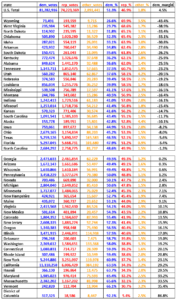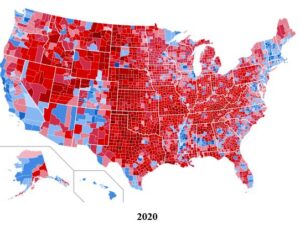Dissecting Red States and Blue States
Presidential election results tend to be used for designating states as red (for Republican) or blue (for Democratic). A U.S. color map of the 2020 election results displays 25 red states and 25 blue states. Five states, Arizona, Georgia, Michigan, Pennsylvania and Wisconsin, changed from red in 2016 to blue in 2020: these states which Trump had won in 2016 were won by Biden in 2020.
 The chart to the right reveals that coloring a state red or blue obscures a wealth of information. (Click on chart to enlarge) Every state had voters for Trump and voters for Biden. The chart ranks the 50 states and District of Columbia by Biden’s margin over Trump in the 2020 election. At the top of the chart the state that gave Trump the largest margin was Wyoming, where Trump’s margin over Biden was 43.4%. The state that gave the most votes to Trump was California, a very blue state. Trump received six million votes in California. Biden, with over eleven million votes, had a 29.2% edge over Trump.
The chart to the right reveals that coloring a state red or blue obscures a wealth of information. (Click on chart to enlarge) Every state had voters for Trump and voters for Biden. The chart ranks the 50 states and District of Columbia by Biden’s margin over Trump in the 2020 election. At the top of the chart the state that gave Trump the largest margin was Wyoming, where Trump’s margin over Biden was 43.4%. The state that gave the most votes to Trump was California, a very blue state. Trump received six million votes in California. Biden, with over eleven million votes, had a 29.2% edge over Trump.
The states in the middle of the chart had the closest vote margins in 2020. Four of the states that changed from red to blue had margins for Biden of 1.2% or less. North Carolina gave Trump the smallest margin among the states he won: 1.3%. No state gave a candidate 70% or more of the total vote. (Washington, DC, however, gave Biden over 90%.)
Overall, 36.1 million Biden voters lived in states won by Trump, and 38.1 million Trump voters lived in states won by Biden. That distorts the mental image of what it means to be a red state or a blue state.
A map color-coded for counties presents a more precise image. The map below was produced for Wikimedia Commons. (Click on map to enlarge.) Shades of blue and red vary in intensity in proportion to the winners’ margins in each county. Note the extensive red shades in Washington, Oregon, California, Arizona and New Mexico, all blue states. Only West Virginia and Oklahoma show no blue counties within their borders.
Typically the blue counties in red states represent urban areas in predominantly rural states. For example, Biden won in only four counties in Missouri, comprising Kansas City, Columbia, and St. Louis Counties and St. Louis City. In Texas most blue counties surround Dallas-Fort Worth, Houston, Austin, San Antonio, El Paso, and some border towns.
Urban areas have more liberal and diverse populations than rural areas. The move to a more conservative politics among rural voters is an expression of what columnist Jamelle Bouie has described as conservative electorates’ pre-existing “anxieties, fears, anger, resentment, rage, about changing cultural and demographic facts about the country. It’s not just that the country is becoming less white, though that’s a part of it. But it’s also that the country is becoming less explicitly Christian, less explicitly deferential to Christian belief. It’s becoming more open and tolerant of different sexualities, different gender identities, different religions.”
An assessment of this viewpoint will follow in the next post on Fifty Year Perspective.

